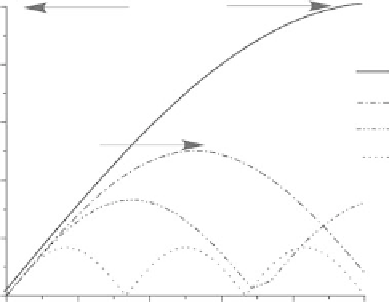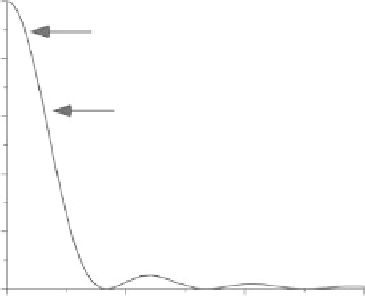Biomedical Engineering Reference
In-Depth Information
(a)
1.0
Δ
k
1
0.8
2Δ
k
1
0.6
0.4
0.2
0.0
0.0
5 × 10
5
1.0 × 10
6
1.5 × 10
6
Δ
k
(m
-1
)
(b)
1.0
L
c
(Δ
k
1
)
0.8
Δ
k
1
2Δ
k
1
0.6
3Δ
k
1
L
c
(2Δ
k
1
)
5Δ
k
1
0.4
0.2
0.0
0.0
0.2
0.4
0.6
0.8
1.0
Domain size
L
c
(Δ
k
)
FIgurE 6.2
Effects of phase mismatch on SHG efficiency. (a) Normalized SHG coupling as function of Δ
k
for val-
ues of Δ
k
1
and 2Δ
k
1
. The increased phase mismatch of the wave vector results in relative decreased SHG conversion
efficiency. (b) Normalized SHG buildup as functions of Δ
k
1
and domain size. The conversion oscillates as sin(Δ
k
L
/2) and domain length,
L
, reaching its first maximum at the respective coherence length. The respective coher-
ence lengths for the two largest (
m
= 1 and 2) are denoted by arrows. (From Lacomb, R. et al. 2008.
Opt. Commun.
281:1823-1832. With permission.)
A plot illustrating the normalized conversion as a function of Δ
k
is given in Figure 6.2a. In biological
tissues, the minimum phase mismatch is governed by dispersion and is denoted by Δ
k
1
. Two sample val-
ues (Δ
k
1
and 2Δ
k
1
, where Δ
k
1
is the wave vector mismatch due to change in index of refraction between
the incident and second harmonic frequency) are shown as examples to demonstrate the decrease in
intensity for increasing values of Δ
k
for relatively small mismatches. Unlike birefringent crystals with
Δ
k
= 0 at specific incident angles of excitation for phase matching between the ordinary and extraordi-
nary waves [38], axial momentum contributions from the media (which are nonsingular due to random-
ness) and dispersion result in a large distribution of Δ
k
values, where the overall SHG intensity includes
contributions from this entire assembly. It will be shown later that the dominant Δ
k
values contributing
to the overall SHG conversion efficiency are determined by both the Δ
k
distribution and domain size.
Here, we present the more general case of an SHG conversion within a domain, which we define as a
local source or distributed collection of SHG radiators, which in tissues can be either single fibrils/fibers


